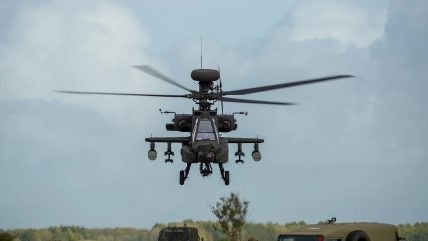
Australia is preparing for the arrival of its first AH-64E Apache helicopters, with five Army pilots already training in the United States the Australian Ministry of Defence (MoD) announced on 13 September 2024.
Australia is expected to receive 29 AH-64E Apaches, the most advanced Apache model, with the first deliveries scheduled for late next year.
The pilots, previously assigned to the ARH Tiger helicopter, are now embedded with the US Army. Drawn from the 1st Aviation Regiment, the pilots completed their conversion training at the US Army Aviation Centre of Excellence in Fort Novosel, Alabama, last year.
The training has continued with integration into various US Army combat aviation units, including the 25th Combat Aviation Brigade in Hawaii, the 16th Combat Aviation Brigade in Washington, and the 101st Airborne Division in Kentucky, with two pilots remaining at Fort Novosel in instructional capacities.
Speaking of the significant differences between the two aircraft in a MoD release, one pilot with almost 1000 hours on the ARH Tiger noted that the Tiger is lighter and more agile, while the Apache is a heavier, more robust machine. “The Apache has a max all-up weight of about 10 tonnes, so you need to be a little bit more accurate with your flying,” the pilot said. “There’s more armaments and armour on board, so there’s more momentum that you’re dealing with.”
The time with the US Army allows them to gain valuable experience in how the AH-64E Apache helicopter is employed in combat scenarios, crucial in shaping Australia’s future Apache operations and tactics.
The US Army’s AH-64E Apache has also integrated the Spike missile system, in addition to the existing joint air-to-ground missiles, which feature laser and radar seekers. These missiles will eventually replace the Hellfire in US operations. The Apache’s advanced sensors and systems, such as the Longbow fire-control radar, enable it to acquire targets at more than double the range of the ARH Tiger. Its capability is further enhanced by data-sharing links like Link 16, which allows for seamless communication with other helicopters and ground units.
While exact sensor capabilities remain classified, it is known that the Apache can detect targets at distances beyond its firing range. The US Army utilises a formation-based approach to manage the vast amount of data generated during missions. A typical formation involves four Apaches, with mixed configurations of Longbow radars and upper-receivers. “Longbow radar aircraft can share their targets, then the troop leader can assign them between the flight to attack,” one Australian Army is quoted as saying to the MoD. “It’s an adrenaline rush to be in a four-ship formation with four aircraft firing simultaneously.”
The US Army’s use of Apache helicopters often involves deep strike missions, supporting division-level manoeuvres. These missions focus on strategic targets ahead of ground troops rather than close air support. “It’s not typically in close proximity to ground forces; more forward of their forward line of own troops to hit strategic targets in depth,” said another pilot.
The pilots are confident that the Australian Army will maximise the Apache’s performance in local conditions. “The new Apache brings the ability to see and detect more, share that information more rapidly and apply more weaponry. It’s a fantastic machine,” an Australian Army pilot told the MoD, before praising the work of those still flying the ARH Tiger, noting it will continue to serve until the Apaches are fully operational.




